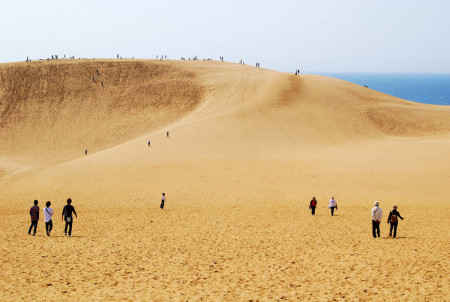
Many people will tell you that Japan has no deserts but whilst the Tottori Sand Dunes might not be able to compare to the Sahara in terms of size, they certainly have a lot in common with it in terms of their appearance. They are vast piles of sand measuring sixteen kilometers from east to west and two kilometers from north to south. The reason that the majority of people don’t view them as a desert is that there is too much rainfall in the area that they are in for them to be technically classed as one. They are still the next best thing though and are an unlikely tourist site. According to an article published in the New York Times, they were formed by sand being carried down from the mountains by the Sendai River and are gradually eroding, meaning that those who want to see them only have a finite amount of time left in order to do so.
From Nuisance to Tourism Hotspot
The Tottori Sand Dunes haven’t always been such an attraction. For centuries they were regarded as a nuisance but then, in the early twentieth century, they began to crop up in Japanese literature, which started the trend of people taking trips to see them. Nowadays nearly two million people journey to Tottori to view them each year. The best time to visit the dunes is in the early morning before the flocks of tourists arrive. Alternatively you might want to share in the wonderment of the hordes of other people who travel to the area to marvel at them during the day.
Sandboarders, Walkers and Photographers
Japan isn’t exactly known for its desert-like landscapes. In fact it rained so heavily in some parts of the country in 2012 that there were floods and at least nineteen people lost their lives. This is precisely why the Tottori Sand Dunes are so appealing; they are at odds with the environment in which they appear. Their steepness also makes them ideal for ‘sandboarders’, who are like snowboarders but prefer dunes to snowy mountains. They are also popular with walkers and amateur photographers, who wish to capture this strange quirk of nature with their lenses.
Tottori Sand Dunes in Literature
As well as traveling to the dunes on account of how out of place they look in their setting, tourists also flock to them because of their literary connection. Takeo Arishima, who was a Japanese writer with a strong female following, referred to them in a poem that he wrote during a visit to the area in which he spoke of the deep misery that he felt whilst standing in the middle of the sand due to the fact that he was having a doomed affair with a married woman. Kobo Abe, who was another well-known Japanese writer, wrote a poem about the dunes entitled ‘The Woman in the Dunes’, which was about a man who fell into a sand pit where a strange woman lived alone.
Well Worth a Visit
The Tottori Sand Dunes are well worth a visit for both fans of Japanese literature and fans of unusual geographical features. They are like a little piece of Egypt that has been transplanted into Japan and possess a mystical, otherworldly quality to them. They are also good for fans of sand-related sports and people who enjoy walking in a novel setting filled with the type of scenery that does not exist anywhere else in Japan. The fact that they are mostly popular with tourists from other parts of Japan means that they provide westerners with the chance to witness a sight that not many other people from outside of the country get to see. It enables you to get an insight into how the local people spend their holidays and witness a spectacle that is regarded as one of the country’s main natural attractions.
How to Get to Tottori Sand Dunes
From Tokyo (By Air): 1h 10 min from Haneda to Tottori Airport, and 19 min from the airport to Tottori Station by bus.
From Osaka (by Rail) 2h 30 min to Tottori Station by Chizu Kyuko Line “Super Hakuto” (limited express), and 20 min from Tottori Station to Tottori-sakyu by bus.
Quick Tottori Travel Tip
Although Tottori has the second lowest crime rate of any Japanese prefecture, it is still advisable to exercise caution, as pickpockets have been known to target tourists on the dunes when they are busy. You can minimize the impact of a theft by ensuring that you have adequate legal cover for your trip, as some travel insurance companies offer protection against this form of crime. If you do have an item stolen then report it to the local police force immediately.
